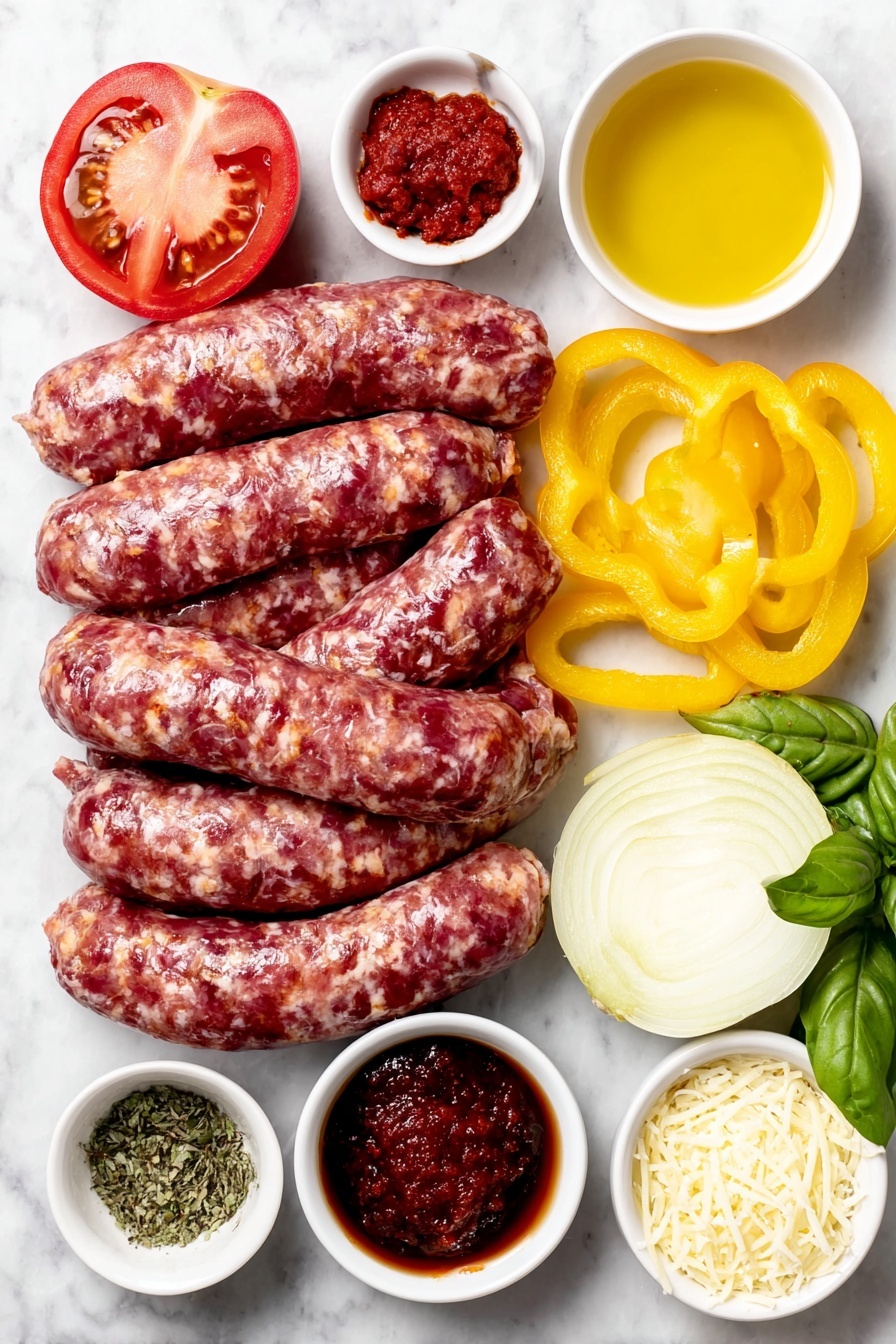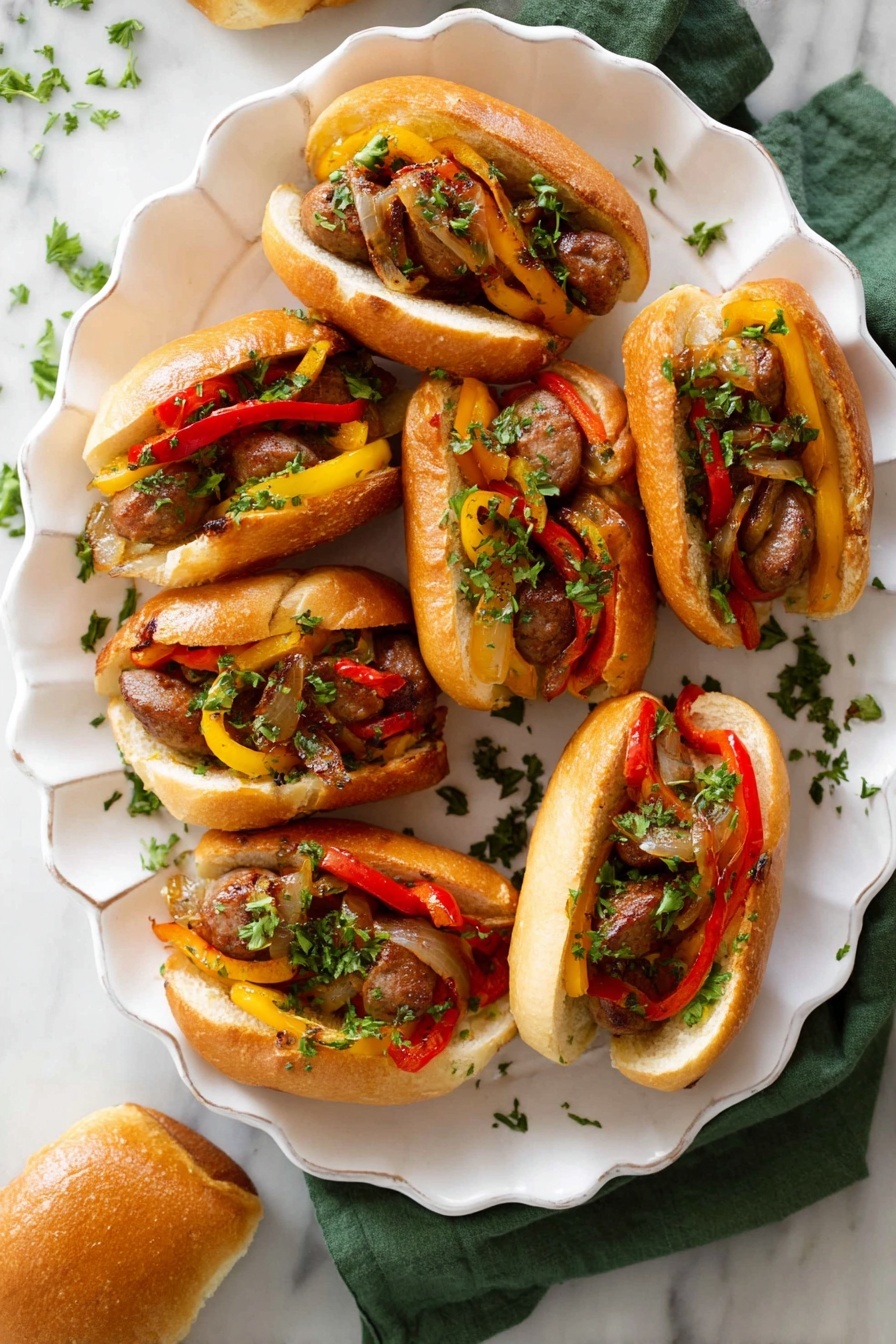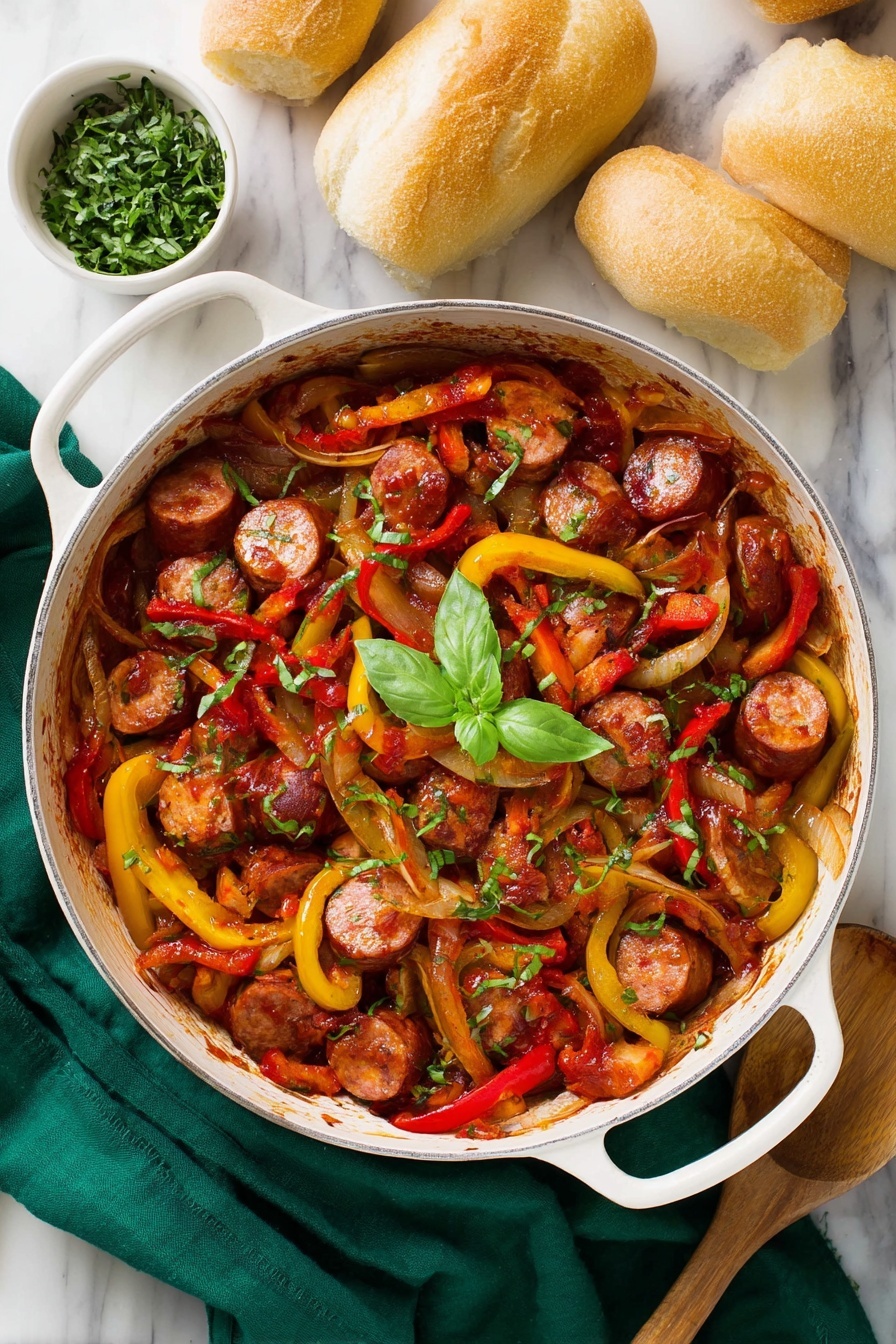There’s something so comforting about a skillet bursting with colorful peppers and savory sausage that makes this Sausage and Pepper Skillet Recipe a true kitchen hero. The blend of sweet, spicy, and tangy flavors comes together in a way that feels both familiar and exciting — perfect for dinner any night of the week.
Jump to:
Why You'll Love This Recipe
Honestly, the first time I made this Sausage and Pepper Skillet Recipe, I was blown away by how simple yet delicious it was. That perfect balance of tender veggies and juicy sausage simmered in a tangy tomato sauce makes it a go-to for busy evenings.
- One-Pan Wonder: Everything cooks together in one skillet, which means less cleanup and more time to enjoy your meal.
- Flavor Packed: The combination of fresh peppers, aromatic garlic, and a splash of balsamic vinegar gives the sauce a beautiful depth.
- Flexible & Customizable: Whether you like it spicy or mild, or want to swap veggies, this recipe adapts to whatever you have on hand.
- Year-Round Appeal: Bright, colorful, and comforting, it’s a dish that feels fresh in summer and cozy in winter.

Ingredients & Why They Work
The ingredients in this Sausage and Pepper Skillet Recipe work together like old friends — each bringing their own flavor and texture to the party. When you pick quality sausage and fresh peppers, you’re halfway to dinner already.

- Italian sausage: Choose mild or spicy depending on your taste; the sausage fat renders out to flavor the entire dish.
- Olive oil: Needed to sauté veggies and add richness without overpowering the herbs and spices.
- Bell peppers: Using different colors — red, yellow, or green — creates a vibrant, sweet, slightly crunchy texture.
- Yellow onion: Adds a natural sweetness and depth once softened in the skillet.
- Tomato paste: Concentrated tomato flavor that thickens the sauce and ties all the ingredients together.
- Garlic: Essential for an aromatic boost and a familiar Italian touch.
- Red pepper flakes: Just a pinch adds warmth without heat; perfect to adjust to your liking.
- Chicken broth: Keeps the sauce juicy and helps cook the sausage through without drying it out.
- Balsamic vinegar: A little acidity to elevate the whole skillet with a subtle tanginess.
- Roma tomato: Fresh tomato slices lend natural juiciness and color next to the cooked bell peppers.
- Fresh basil: Bright and fragrant, it brings a garden-fresh note that pairs perfectly with Italian sausage.
- Dried oregano: Warm and earthy, grounding the dish in classic Italian seasoning.
- Parmesan cheese: Shredded finely for a nutty finish that melts into the skillet just before serving.
- Fresh parsley or additional basil: Used as garnish for an inviting, fresh look and flavor pop.
Make It Your Way
I love tweaking this Sausage and Pepper Skillet Recipe depending on what’s in my fridge or the mood I’m in. Don't be shy about swapping things around—you can easily make it your own!
- Variation: Sometimes I swap out Italian sausage for chorizo or chicken sausage for a fun twist that still keeps that rich flavor base.
- Vegetable swaps: Adding mushrooms or zucchini is a great way to stretch the dish and add texture, especially if you want to sneak in more veggies.
- Heat level: Play with the red pepper flakes or use spicy sausage if you like it with some zip—you control how bold this skillet gets.
- Cheese options: I’ve also tried Pecorino Romano instead of Parmesan for a sharper punch, and it’s delightful.
Step-by-Step: How I Make Sausage and Pepper Skillet Recipe
Step 1: Brown the Sausage to Lock in Flavor
Start by heating olive oil over medium heat in a large skillet. Add your Italian sausage links and brown them evenly on all sides. This usually takes 8 to 10 minutes. The goal here is a beautiful caramelized crust that adds so much depth to the dish. Once browned, transfer the sausages to a plate but leave all those flavorful browned bits and sausage fat in the pan — this will become the foundation of your sauce.
Step 2: Sauté Peppers and Onions
With the pan still hot, add your sliced bell peppers and onions. Sauté them for about 3 minutes until they start to soften but still hold some bite. Don’t rush this because it’s the sweet, slightly crunchy peppers that give this recipe its signature texture. Keep everything moving in the skillet to prevent burning.
Step 3: Build the Sauce
Next, stir in tomato paste, minced garlic, and red pepper flakes. Cook everything for about a minute to awaken those flavors and soften the garlic slightly — this little step really amps up the freshness and aroma.
Step 4: Add Liquids & Herbs, Simmer Gently
Pour in chicken broth and balsamic vinegar, then toss in slices of fresh roma tomato, chopped basil, dried oregano, and season with salt and freshly cracked pepper. Give everything a good stir. Now nestle your sausage back into the skillet, pushing them slightly into the pepper mixture.
Bring the skillet to a gentle simmer, then turn the heat down low and cover. Let it cook until the sausages reach an internal temperature of 160°F and the peppers are tender — about 10 minutes. If your sauce looks too thick or dry, add a little more chicken broth to loosen it up.
Step 5: Rest, Slice, and Finish
Remove the sausages to a cutting board and tent them loosely with foil, letting them rest for 5 minutes. Keep the pepper mixture covered and warm in the skillet. Then slice the sausages into rounds and return them to the pan. Toss everything with finely shredded Parmesan cheese until melted and combined. Garnish with fresh basil or parsley before serving.
Top Tip
From my experience making the Sausage and Pepper Skillet Recipe, a few little tricks really elevate the outcome. These tips helped me avoid common mishaps and get the flavors just right every single time.
- Don’t skip browning: Taking the time to brown the sausage properly adds caramelized flavor that makes the whole dish sing.
- Use fresh herbs at the end: Adding basil right before serving keeps it fragrant and fresh, rather than wilted or bitter.
- Watch your heat: Keep your skillet at medium to medium-low after adding liquids so the sauce simmers gently without scorching.
- Resting the sausage: Slicing resting sausages helps keep them juicy and lets the flavors settle.
How to Serve Sausage and Pepper Skillet Recipe

Garnishes
I always top my skillet with a handful of chopped fresh basil or parsley because it adds a lovely pop of green and brightness that balances the rich sausage. A sprinkle of freshly grated Parmesan right at the end also works wonders for that cheesy, nutty touch you crave.
Side Dishes
This Sausage and Pepper Skillet Recipe pairs beautifully with crusty Italian bread to scoop up every last bit of sauce. You could also serve it over creamy polenta, fluffy rice, or garlic buttered pasta—whatever feels right for the occasion.
Creative Ways to Present
For a fun twist at gatherings, I like serving the sausage and peppers on toasted hoagie buns with melted provolone for a hearty sandwich. It’s perfect for casual dinners or game day. You can also spoon it over roasted potatoes for a comforting, fork-friendly plate that kids and adults both love.
Make Ahead and Storage
Storing Leftovers
I usually store leftovers in an airtight container in the fridge for up to 3 days. The sausage stays juicy, and the pepper mixture actually tastes better after a day once the flavors meld even more.
Freezing
This skillet freezes well too. I portion out sausage and pepper mixture into freezer-safe containers. When thawed in the fridge overnight and gently reheated, it tastes like fresh-made with no loss in texture.
Reheating
When reheating, I prefer warming it over low heat on the stove with a splash of chicken broth to keep everything juicy. Avoid the microwave if you can, as gentle reheating preserves the sausage’s tenderness and the peppers’ texture better.
Frequently Asked Questions:
Definitely! While Italian sausage is traditional, you can substitute chicken sausage, chorizo, or even turkey sausage depending on your preference. Just mind the spices and adjust cooking times slightly if needed.
You control the heat! Using mild Italian sausage and reducing or skipping red pepper flakes will keep it gentle. Using spicy sausage and more flakes will give it a kick. It’s easy to customize to your taste.
Absolutely. You can fully make the skillet and store it in the fridge up to 3 days before serving. Just reheat gently and add a splash of chicken broth if the sauce thickens too much.
Crusty Italian bread, creamy polenta, roasted potatoes, or simple garlic buttered pasta all pair beautifully with this skillet for a hearty, satisfying meal. Choose sides that soak up the delicious sauce!
Final Thoughts
This Sausage and Pepper Skillet Recipe holds a special place in my weekly rotation because it’s reliably tasty, quick, and adaptable. It’s one of those dishes that feels like a warm hug at the end of a busy day but also impresses when you serve it to friends. Give it a try—you’ll find yourself coming back to this skillet again and again, just like I do.
Print
Sausage and Pepper Skillet Recipe
- Prep Time: 20 minutes
- Cook Time: 20 minutes
- Total Time: 40 minutes
- Yield: 5 servings
- Category: Main Course
- Method: Stovetop
- Cuisine: Italian
Description
This Sausage and Peppers recipe features Italian sausage links cooked with colorful bell peppers, onions, and a savory tomato-based sauce with garlic, basil, and oregano. It's a comforting main dish perfect for serving with hoagie buns, potatoes, or pasta.
Ingredients
Sausage and Vegetables
- 5 Italian sausage links (20 oz.), mild or spicy
- 1 tablespoon olive oil
- 2 large bell peppers (one red, and one yellow or green), cored and sliced
- 1 large yellow onion, sliced
Sauce and Seasonings
- 3 tablespoon tomato paste
- 1 tablespoon minced garlic
- ½ teaspoon red pepper flakes, or to taste
- ¾ cup low-sodium chicken broth, then more to taste
- 1 tablespoon balsamic vinegar
- 1 large roma tomato, halved and sliced
- 3 tablespoon chopped fresh basil
- 1 teaspoon dried oregano
- ¼ cup finely shredded parmesan cheese (grate with a rasp grater)
- Chopped fresh basil or parsley, for garnish
Instructions
- Brown the sausage: Heat olive oil in a large skillet over medium heat. Add the sausage links and cook until browned on all sides, about 10 minutes. Transfer the sausages to a plate, leaving the rendered fat in the skillet.
- Sauté peppers and onions: Return the skillet to medium heat and add the sliced bell peppers and onions. Sauté for 3 minutes until they start to soften.
- Add tomato paste and spices: Stir in the tomato paste, minced garlic, and red pepper flakes. Cook for 1 minute to release the flavors.
- Add liquids and herbs: Pour in the chicken broth and balsamic vinegar. Add the sliced roma tomato, chopped fresh basil, dried oregano, and season with salt and pepper to taste. Toss the mixture to combine.
- Simmer sausages with peppers: Nestle the browned sausages into the pepper mixture. Bring to a simmer, then reduce heat to low. Cover and simmer gently for 10 minutes until the sausages reach 160°F internally and the peppers are tender. Add an extra ¼ cup chicken broth if the sauce needs thinning.
- Rest sausages: Remove the sausages from the pan and let them rest covered loosely with foil for 5 minutes. Keep the pepper mixture covered in the pan to stay warm.
- Slice and combine: Slice the rested sausages and return them to the pan with the pepper mixture. Stir in the shredded parmesan cheese and toss to combine.
- Garnish and serve: Garnish with additional fresh basil or parsley. Serve the sausage and peppers in hoagie buns or alongside potatoes, rice, polenta, or pasta.
Notes
- Use mild or spicy Italian sausage according to your preference for heat.
- Substitute chicken broth with vegetable broth for a different flavor profile.
- If you prefer, using sweet bell peppers only will make the dish milder.
- You can prepare this dish ahead and reheat gently; the flavors meld beautifully over time.
- Serve with crusty bread or on hoagie rolls for a classic sandwich style.
- Grating fresh parmesan cheese adds more authentic flavor than pre-shredded cheese.
Nutrition
- Serving Size: 1 serving
- Calories: 380 kcal
- Sugar: 6 g
- Sodium: 580 mg
- Fat: 26 g
- Saturated Fat: 9 g
- Unsaturated Fat: 15 g
- Trans Fat: 0 g
- Carbohydrates: 10 g
- Fiber: 3 g
- Protein: 22 g
- Cholesterol: 70 mg







Leave a Reply